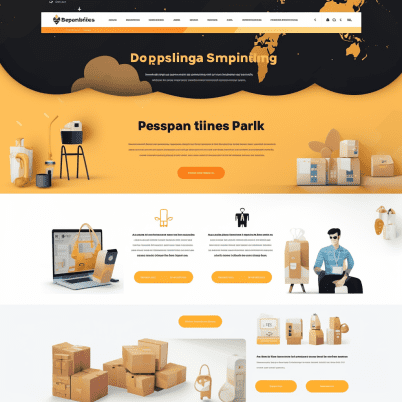In the ever-evolving landscape of e-commerce, knowing “how to start a dropshipping business” can lead to an enticing and lucrative venture. Dropshipping enables entrepreneurs to establish an online store without the burdens of inventory management. If you’ve been contemplating launching your own dropshipping venture but aren’t sure where to begin, you’ve come to the right place. This comprehensive guide will walk you through the essentials of starting a dropshipping business, covering everything from niche selection to handling customer service, and answer frequently asked questions to ensure you’re well-prepared for success.

1. Understanding Dropshipping: How to Start a Dropshipping Business
How to Start a Dropshipping Business? Dropshipping is a business model that allows entrepreneurs to sell products to customers without the need to maintain physical inventory. Instead, the retailer partners with suppliers who handle inventory storage, packaging, and shipping directly to the customers. As a dropshipper, you act as the intermediary, earning profits from the difference between the wholesale and retail prices.
2. The Advantages of Dropshipping
Dropshipping offers several benefits that make it an attractive option for aspiring entrepreneurs:
Low startup costs:
The initial investment required how to start a dropshipping business is significantly lower compared to traditional retail models. You can avoid large inventory purchases and focus on building your online store and marketing efforts.
Flexibility and Location Independence:
With an internet connection, you can run your dropshipping business from anywhere in the world. This flexibility allows you to manage your business while traveling or working from home. learn “how to start a dropshipping business”.
Wide Product Selection:
Dropshipping enables you to offer a diverse range of products to your customers without being limited by physical storage space. You can test various products and niches to find what resonates best with your audience.
Reduced Risk:
Since you don’t need to purchase inventory upfront, you can avoid the risks associated with unsold products or inventory obsolescence. This risk reduction is particularly beneficial for entrepreneurs on a tight budget.
3. Finding Your Niche in the Dropshipping World
Finding the right niche is crucial for the success of your how to start a dropshipping business. Here’s how you can identify a profitable niche:
Passion and Interest:
Choose a niche that aligns with your interests and knowledge. Your enthusiasm for the products will motivate you to invest time and effort into your business.
Market Research:
Conduct thorough market research to identify trends, customer preferences, and potential competitors in your chosen niche. Look for gaps in the market that you can fill with unique products or offerings how to start a dropshipping business.
Solving Problems:
Consider products that solve specific problems or address unmet needs in the market. Solving pain points for customers can lead to increased demand for your products.
4. Choosing the Right Products for Your Dropshipping Store
Selecting the right products is a critical step in building a successful dropshipping business. Keep the following factors in mind:
Profit Margins:
Focus on products that offer reasonable profit margins. You need to cover your expenses, including marketing, shipping, and transaction fees, while still making a profit.
Quality and Reliability:
Partner with suppliers who offer high-quality products and have a track record of reliable shipping and customer service. This will help you build trust with your customers.
Product Appeal:
Choose products that have broad appeal and can cater to a wide range of customers. Consider products that are evergreen, not just trendy items that might lose popularity quickly.
Shipping Times:
Evaluate the shipping times offered by your suppliers. Customers value timely delivery, so working with suppliers who can deliver products quickly is crucial for customer satisfaction.
5. Selecting Reliable Suppliers for Your Dropshipping Business
Finding trustworthy suppliers is vital for the smooth operation of your dropshipping business. Consider the following when evaluating potential suppliers:
Product Range:
Look for suppliers who offer a diverse range of products within your niche. A wide product selection gives you more options to cater to various customer preferences.
Reliability and Reputation:
Research potential suppliers thoroughly. Check online reviews, testimonials, and ratings to gauge their reliability and reputation in the industry.
Communication and Responsiveness:
Choose suppliers who communicate effectively and respond promptly to inquiries. Good communication is essential for resolving any issues that may arise.
Shipping Costs:
Evaluate the shipping costs charged by your suppliers. High shipping costs can deter customers from completing their purchases.
6. Setting Up Your Online Store for Dropshipping Success
Creating a well-designed and user-friendly online store is essential for attracting and retaining customers. Follow these steps to set how to start a dropshipping business:
E-commerce Platform:
Choose a reliable e-commerce platform that suits your needs. Popular options include Shopify, WooCommerce, and BigCommerce. These platforms offer a range of features to help you build and manage your online store.
Domain and Branding:
Select a domain name that represents your brand and is easy to remember. Invest in branding elements such as a logo, color scheme, and website layout that align with your niche and target audience.
Product Listings:
Craft compelling and detailed product descriptions. Use high-quality images and provide all the necessary information to help customers make informed purchasing decisions.
Secure Payment Gateway:
Integrate a secure and user-friendly payment gateway to ensure smooth and secure transactions for your customers.
7. Effective Marketing Strategies for Your Dropshipping Venture
Marketing is crucial for driving traffic to your dropshipping store and converting visitors into customers. Here are some effective marketing strategies:
Search Engine Optimization (SEO):
Optimize your website and product pages for relevant keywords to improve your search engine rankings and organic traffic.
Social Media Marketing:
Leverage popular social media platforms like Facebook, Instagram, and Pinterest to reach your target audience. Create engaging content, run ads, and interact with your followers to build a loyal customer base.
Influencer Marketing:
Collaborate with influencers or bloggers in your niche to reach a wider audience and gain credibility. Influencers can help promote your products and drive traffic to your store.
Email Marketing:
Build an email list and send regular updates, promotions, and exclusive offers to keep customers engaged and encourage repeat purchases.
8. Providing Outstanding Customer Service in Your Dropshipping Business
Excellent customer service is crucial for building a positive brand reputation and fostering customer loyalty. Follow these tips for exceptional customer service:
Prompt Responses:
Respond to customer inquiries and concerns promptly. Show your customers that you value their time and are committed to providing excellent service.
Clear Communication:
Maintain transparent communication with your customers throughout the order process. Keep them informed about shipping times, tracking information, and any potential delays.
Customer Feedback:
Encourage customers to leave reviews and feedback. Use this valuable information to improve your products and services continuously.
9. Order Fulfillment and Handling Returns in Your Dropshipping Store
While the supplier handles order fulfillment, you must have a clear plan for handling returns and refunds. Here’s what you can do:
Transparent Policies:
Clearly communicate your return and refund policies on your website. Set realistic expectations for customers to manage their post-purchase experiences.
Quality Control:
Regularly review product quality and supplier performance to ensure your customers receive high-quality products.
10. Scaling Your Dropshipping Business for Greater Success
As your dropshipping business grows, you’ll want to scale effectively to maximize profits and efficiency. Consider the following strategies:
Automate Processes:
Utilize automation tools and software to streamline tasks such as order processing, customer support, and inventory management.
Diversify Marketing Channels:
Explore additional marketing channels to reach a broader audience and reduce reliance on a single platform. Test different marketing strategies to identify what works best for your business.
Expand Product Range:
Gradually expand your product range to cater to evolving customer demands. Add complementary products to your existing offerings to increase average order values.
11. Common Mistakes to Avoid in Dropshipping
Avoiding common pitfalls can save you time, money, and frustration. Steer clear of the following mistakes:
Ignoring Customer Feedback:
Listen to your customers and use their feedback to make improvements to your store, products, and customer service.
Overexpanding:
Resist the temptation to add too many products or niches too quickly. Focus on a few core products initially, and expand strategically as you gain traction.
Underestimating Costs:
Consider all the costs involved in running your how to start a dropshipping business, including advertising, marketing, transaction fees, and taxes. Accurately factor these expenses into your pricing strategy.
12. Frequently Asked Questions (FAQs) about How to Start a Dropshipping Business
Q1: How much money do I need to start a dropshipping business?
A1: The initial investment required for how to start a dropshipping business varies depending on factors such as your niche, supplier requirements, and marketing budget. Generally, you can start with a few hundred to a few thousand dollars.
Q2: Can I dropship products from multiple suppliers?
A2: Yes, you can work with multiple suppliers to offer a diverse range of products. However, managing multiple suppliers requires effective coordination and organization.
Q3: How do I handle customer inquiries about shipping times?
A3: Be transparent with your customers about shipping times. Provide estimated delivery times and tracking information to keep them informed.
Q4: What happens if a product is out of stock with the supplier?
A4: Inventory fluctuations can occur. In such cases, promptly inform affected customers, offer alternatives if available, and issue refunds when necessary.
Q5: How do I handle sales tax in dropshipping?
A5: Sales tax regulations vary based on your location and the locations of your customers. Consult with a tax professional to understand and comply with applicable tax laws.
Q6: Is dropshipping saturated?
A6: While the how to start a dropshipping business market has seen significant growth, there are still plenty of opportunities for innovative entrepreneurs. Focus on finding a unique niche and providing exceptional customer service to stand out from the competition.
Conclusion:
Knowing “how to start a dropshipping business” can lead to a rewarding journey, but it requires careful planning, research, and execution. By identifying a profitable niche, selecting reliable suppliers, setting up a user-friendly online store, and implementing effective marketing strategies, you can lay a strong foundation for your dropshipping success. Remember to prioritize customer satisfaction, continuously improve your products and services, and be proactive in adapting to market trends. Armed with the knowledge from this guide and answers to frequently asked questions, you’re well-equipped to embark on your dropshipping adventure. Best of luck on your entrepreneurial journey!




